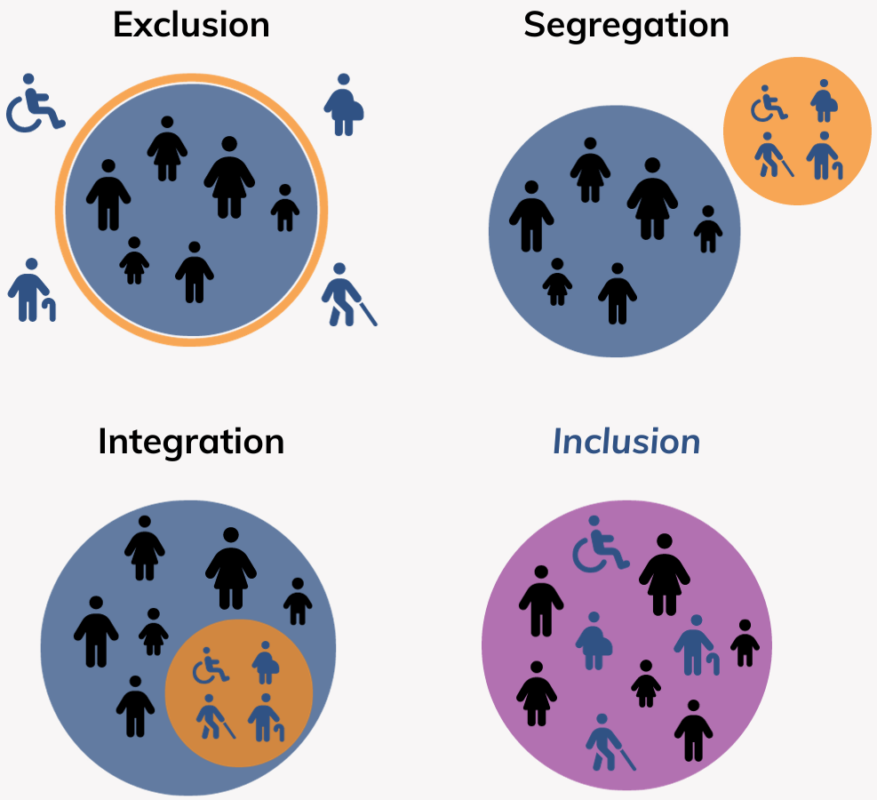A ascensão da programação de educação inclusiva marca uma mudança significativa em relação aos modelos tradicionais de educação para crianças com deficiência. Muitas vezes confrontados com estigma e falta de recursos, crianças com deficiência foram historicamente segregadas de seus pares por frequentarem escolas separadas, matricular-se em turmas de educação especial, recebendo educação através do ensino em casa, ou simplesmente perdendo completamente a educação.

A educação inclusiva está agora a tornar-se mais prevalente, e as evidências mostram que quando bem feito, proporciona os maiores benefícios tanto para os alunos recém-incluídos, como também para a população escolar e de sala de aula em geral.
O que é educação inclusiva?
Muito simplesmente, educação inclusiva significa que todas as crianças frequentam a mesma aula e aprendem o mesmo conteúdo. Independentemente da capacidade ou deficiência, as crianças se matriculam na escola local para aprender junto com colegas de sua comunidade, e o sistema educativo tem a tarefa de garantir o acesso físico às escolas e fornecer acomodações para a plena participação na aprendizagem.
Embora a implementação de uma educação inclusiva eficaz possa exigir um investimento inicial significativo em tempo e recursos, os benefícios são duradouros e generalizados. E embora existam muitas justificações para a educação inclusiva, Vou destacar dois: melhorar a educação de qualidade para TODOS estudantes e promovendo uma comunidade mais forte.
Educação inclusiva é educação de qualidade
Quando pensamos em educação inclusiva, muitas vezes nos concentramos nas práticas dos professores para apoiar crianças com deficiência. Isso é impreciso. A educação inclusiva não se trata de fornecer educação a crianças com deficiência, mas sim melhorar a qualidade da educação para garantir que TODOS os alunos possam aprender numa aula.
As práticas de educação inclusiva são em grande parte construídas com base em Design Universal para Aprendizagem (UDL), que promove ambientes de aprendizagem “acessíveis, inclusivo, equitativo, e desafiador para todos os alunos. A estrutura incentiva os educadores a fornecer múltiplas maneiras para os alunos se envolverem e aprenderem novos materiais, e múltiplas maneiras de demonstrar o que aprenderam. Embora esta diferenciação beneficie os alunos com deficiência, também promove maior engajamento e aprendizado para toda a turma.
Imaginar, por exemplo, que um aluno tem dislexia grave. Eles olham para a página e as letras se sobrepõem, palavras correm juntas. Ler um pequeno texto de um livro pode não ser a melhor maneira para esse aluno aprender um novo conteúdo. Em vez de, este aluno pode se beneficiar ouvindo material de áudio. Se este método fosse disponibilizado a todos os alunos, também pode beneficiar um aluno com um nível de leitura inferior, um aluno com deficiência visual, ou um aluno que ainda está aprendendo o idioma de instrução. É improvável que todos esses alunos tenham uma deficiência diagnosticada, mas todos beneficiariam desta forma adicional de interagir com o material.
Fornecer instrução diferenciada também incentiva os professores a presumir competência e estabelecer altas expectativas acadêmicas para alunos com e sem deficiência. Quando crianças com deficiência são colocadas em turmas ou escolas separadas, é fácil simplificar as lições para garantir que sejam bem-sucedidas. Isso muitas vezes vem com boas intenções – os professores querem que seus alunos se sintam bem-sucedidos – mas nem sempre ajuda os alunos a longo prazo ou reconhece seu verdadeiro potencial acadêmico.. Em uma sala de aula inclusiva, o padrão muda para identificar maneiras de garantir que todos os alunos possam atingir o objetivo de aprendizagem, mesmo que o conteúdo deva ser ensinado de forma diferente ou sejam necessários recursos adicionais.
Promover a comunidade
Olhando através de sua classe, um professor deve ver uma versão menor de sua comunidade. As escolas do bairro devem refletir a população em geral, espelhando e celebrando sua diversidade - considerando diferenças como sexo, etnia ou religião. Através desta atmosfera, as crianças são expostas à diversidade e aprendem a navegar no mundo ao seu redor. No entanto, quando indivíduos com deficiência são segregados no sistema escolar, as crianças crescem vendo-as como “outras”. Simultaneamente, as crianças com deficiência aprendem que não têm lugar para interagir com os seus pares sem deficiência.
Essas mentalidades são transportadas para a idade adulta. A segregação nas escolas muitas vezes leva à segregação na comunidade em geral, uma vez que as mesmas práticas exclusivas são refletidas fora da sala de aula. Se as crianças com deficiência não forem vistas como parte da comunidade escolar, então os adultos com deficiência receberão o mesmo tratamento, sem acesso à força de trabalho, espaços comunitários, e práticas sociais. Através da educação inclusiva, no entanto, as escolas estabelecem TODAS as crianças como membros iguais da comunidade. Ensina todas as crianças a se envolverem com aqueles que são diferentes de si mesmas e a presumir competência mesmo naqueles que parecem ou aprendem de forma diferente.. Como tal, tanto as crianças com como sem deficiência são criadas com a mentalidade de que todas têm um lugar valorizado na sociedade. Ao atingir a idade adulta, então será natural, por exemplo, trabalhar em um local de trabalho com colegas com e sem deficiência.
Promover um sentimento de pertencimento, fortalecer as relações entre os diversos pares e promover a integração na comunidade mais ampla são benefícios da educação inclusiva. Embora o acesso a aulas de qualidade, conteúdo educacional e materiais de aprendizagem são extremamente importantes, os benefícios sociais da educação inclusiva para TODOS os alunos são o que criará uma mudança social duradoura que mudará o estigma de longa data e conduzirá a sociedades mais inclusivas dentro e fora das escolas.